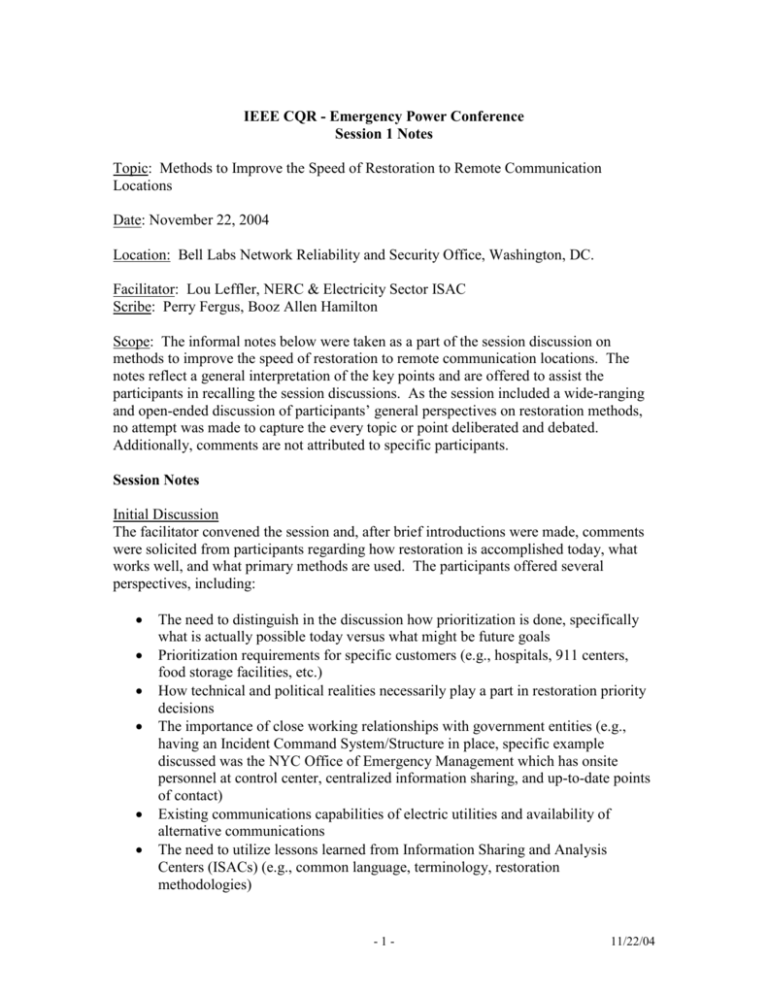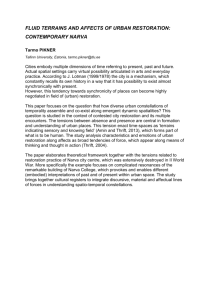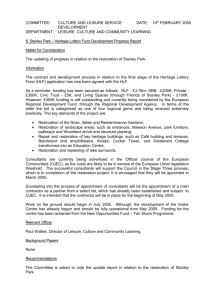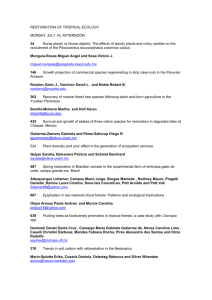Session 1
advertisement

IEEE CQR - Emergency Power Conference Session 1 Notes Topic: Methods to Improve the Speed of Restoration to Remote Communication Locations Date: November 22, 2004 Location: Bell Labs Network Reliability and Security Office, Washington, DC. Facilitator: Lou Leffler, NERC & Electricity Sector ISAC Scribe: Perry Fergus, Booz Allen Hamilton Scope: The informal notes below were taken as a part of the session discussion on methods to improve the speed of restoration to remote communication locations. The notes reflect a general interpretation of the key points and are offered to assist the participants in recalling the session discussions. As the session included a wide-ranging and open-ended discussion of participants’ general perspectives on restoration methods, no attempt was made to capture the every topic or point deliberated and debated. Additionally, comments are not attributed to specific participants. Session Notes Initial Discussion The facilitator convened the session and, after brief introductions were made, comments were solicited from participants regarding how restoration is accomplished today, what works well, and what primary methods are used. The participants offered several perspectives, including: The need to distinguish in the discussion how prioritization is done, specifically what is actually possible today versus what might be future goals Prioritization requirements for specific customers (e.g., hospitals, 911 centers, food storage facilities, etc.) How technical and political realities necessarily play a part in restoration priority decisions The importance of close working relationships with government entities (e.g., having an Incident Command System/Structure in place, specific example discussed was the NYC Office of Emergency Management which has onsite personnel at control center, centralized information sharing, and up-to-date points of contact) Existing communications capabilities of electric utilities and availability of alternative communications The need to utilize lessons learned from Information Sharing and Analysis Centers (ISACs) (e.g., common language, terminology, restoration methodologies) -1- 11/22/04 The need to accurately describe what the outage situation is. Restoration priorities (of utilities) may be largely dependent on the situation at hand, and at times a utility may not know that an outage has occurred The need for faster sharing of information Impacts on restoration effectiveness due to changes in operational environment/business environment (e.g., the increased difficulty in identifying and reaching the correct points of contact (POC) to resolve issues, more unpublished numbers, greater employee turnover leading to unclear roles/responsibilities) Potential use of Automatic Meter Reading (AMR) system/Global Positioning System (GPS) capabilities to assist in restoration for high priority public safety/land mobile radio systems The need for better coordination with utilities regarding priorities planning The need to understand/enhance contact with the customer Sharing of “Brown out” and maintenance plans/schedules Effectiveness of an organizational culture that promotes prevention versus reaction Use of ISACs as a resource for identifying POCs Documenting requirements per site ahead of time and potential use of prioritization template A two-pronged approach to restoration depending on outage severity: 1) Big picture response via the ISACs, and 2) a more focused and targeted local response. (Potential need to categorize methods based on approach) An awareness of the distributed nature of wireless infrastructure as a complicating factor in restoration (e.g., cell site connectivity versus wireline infrastructure, dynamic and distributed customer base) How wireless industry can discuss its restoration priority needs and potential difficulties considering competing needs of other entities (e.g., hospitals, 911 centers, water, plant) An exchange on varying abilities of utilities to predict restoration status and inform customers. Abilities vary widely depending on the outage severity, timing and location, available resources, and other factors. Ballpark estimates may or may not be possible, as there is not one-size-fits-all solution to managing customer expectations. Effective use of National Communications System (NCS)-managed Government Emergency Telecommunications Service (GETS), Wireless Priority Service (WPS), Telecommunications Service Priority (TSP), and Telecommunications Electric Service Priority (TESP) programs to assist in restoration (e.g., communications during restoration, priority provisioning and restoration of resources) The potential need to hold discussions with public utility commissions (PUCs) regarding consideration of legal issues with priority assignments The proper roles regarding defining/providing restoration priority (e.g., appropriate roles of government, utilities, and service providers) -2- 11/22/04 The need for practical planning by wireless providers ahead of time, and specifically taking power considerations into account when placing assets (location) Enhancing overall reliability of grid through maintenance (as appropriate in consideration of business factors) Potential issues with sharing of critical infrastructure information (need to be protected, e.g., PCII). Preparation of Session Readout In preparing for the post-session readout, the participants identified critical items for consideration and agreed that the key take away from the discussion was that “communications is key” in improving the speed of restoration to remote communications locations. The group further refined their findings by brainstorming via white board to identify critical steps before, during, and after occurrence of an outage. The key summary points were developed and documented as follows: What’s most critical Identifying critical locations (e.g., cell sites) ahead of time to ensure proper redundancy The need for common language/terminology and defined criteria regarding priority assignments Agreed upon standards as to what is critical An understanding that response methods are dependent on outage scale (e.g., large versus small) Selected restoration methods must be attainable, “doable”, and consider business realities Key Take Away from Discussion: Communications is Key Before: Need to know what is important ahead of time (better exchange across segments as to what needs are) Pre-communicate to enable better utilization of resources Understanding requirements of wireless (many cell sites, highly distributed) Regularly exercise plans Share planning and maintenance/“brown out” scheduling Practical planning by wireless provider ahead of time/taking power considerations into account when placing assets (location) During: Sharing of info out from utility Use of web sites/tools to share information (e.g. Jacksonville) Near-real time updates/maps After: -3- 11/22/04 Document lessons learned post restoration and incorporate into future planning TESP (Identify what types of information would be useful to share, e.g., existing backup capabilities at sites, defining common language, potential use of existing TSP categories, update Memorandum Of Agreement). Development of Next Steps In concluding the session, the facilitator reviewed the next steps agreed to by the participants: NCS to update TESP documents (e.g., MOA) to incorporate lessons learned from the session discussion Group participants to continue to coordinate with Network Reliability and Interoperability Council (NRIC) Wireless Focus Group addressing “gaps” in restoration priority and developing mitigating best practices Session scribe to develop summary notes/discussion points for distribution and continue exchange via email Involve greater community, e.g., associations, TESP community, in discussion. The facilitator thanked the session participants for their valuable contributions to the discussions and called the session to a close. -4- 11/22/04






